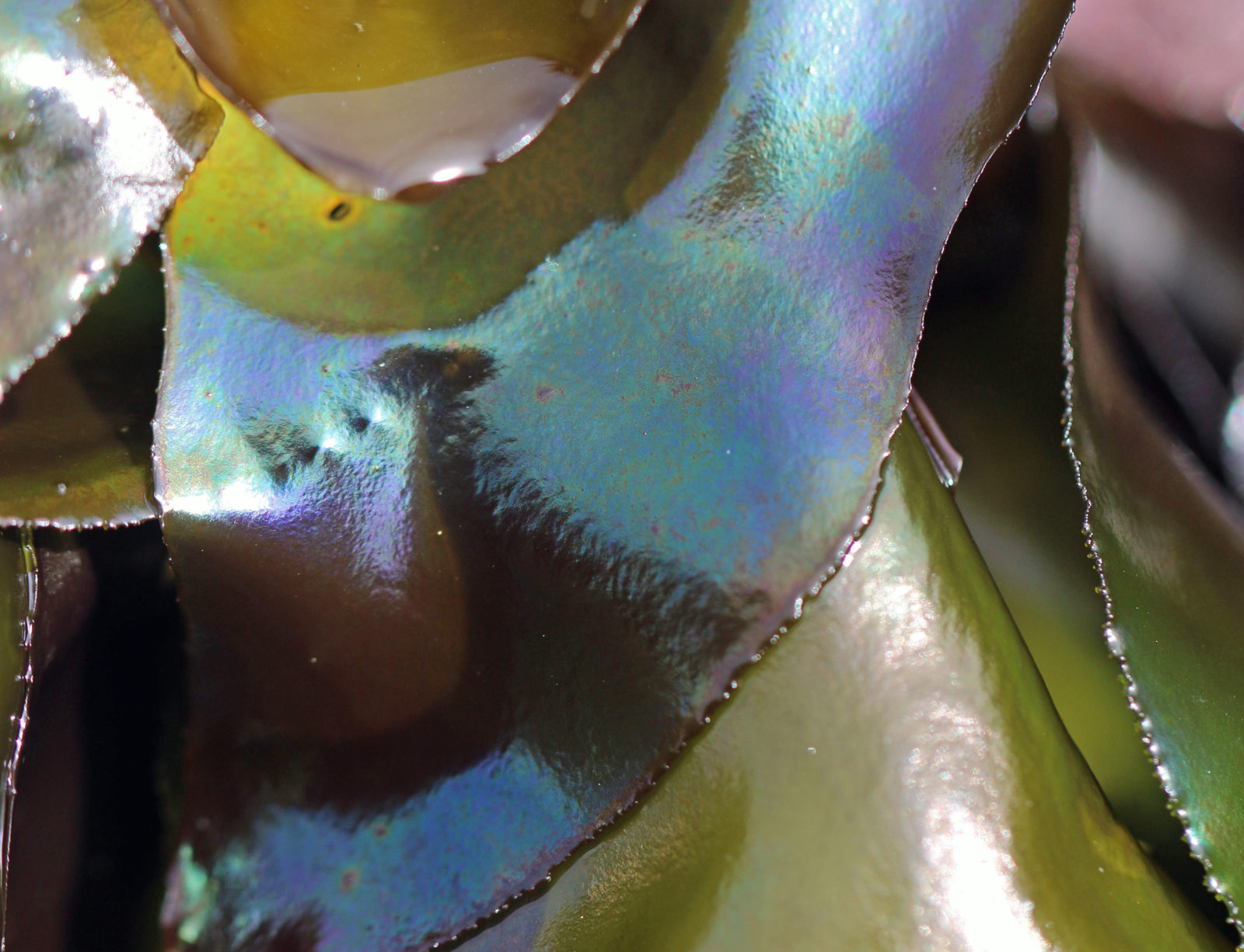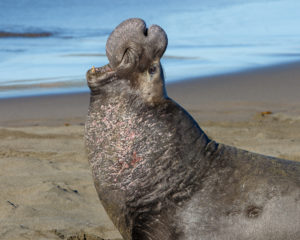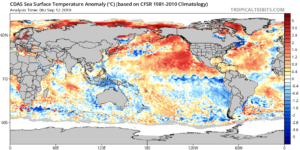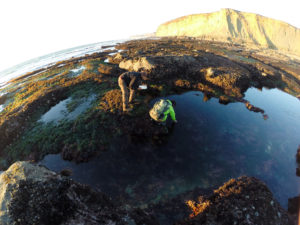If you’ve ever stepped into a certain kind of beach town gift shop on the Northern California coast, you are likely familiar with Josie Iselin’s work: an artist, Iselin creates slim coffee table books filled with detailed, dramatically lit photographs of the souvenirs she finds on her many beachcombing expeditions—stones, interestingly shaped sea glass, shells. But one of her enduring passions is, well, less durable. “I fell in love with seaweed at the kitchen counter,” she writes in her 2014 book An Ocean Garden: The Secret Life of Seaweed. “I had returned from the windswept beach with a sack full, and as I dropped each specimen into a tub of salt water, its form and color and translucent sensuality awakened. … As I teased out the delicate blades, they would stick to my fingers or to each other… I felt like I was unraveling secrets that few have seen.”
“But that book was just a start,” Iselin writes in her latest book, The Curious World of Seaweed, out this month from Heyday. This second seaweed-related volume features essays about sixteen kinds of seaweed found specifically on the California coast, with a couple sea grasses thrown in for good measure. (Seaweeds, we learn, were the evolutionary precursors to the flowering plants and trees we’re familiar with, while sea grasses are terrestrial flora who have recolonized the ocean.) Each essay is illustrated with lavish “algal portraits” Iselin captured with her flatbed scanner, often of specimens that she found herself in Mendocino or Monterey or Pacific Grove or Keller Beach or Fort Funston. These images sit alongside, or sometimes on top of, scientific illustrations and lithographs of seaweeds from 18th and 19th century catalogues compiled by naturalists passionately interested in this translucent, obscure corner of nature. “I intend to study my favourite and useless class, Cryptogamia,” wrote one pioneering 19th century botanist, a Quaker named William Henry Harvey, about nonflowering plants (including algae) at the ripe age of 15. “I think I hear thee say, Tut-tut! But no matter. To be useless, various, and abstruse, is a sufficient recommendation of a science to make it pleasing to me.”
Remember, they are an exotic species in the Western United States, and are rapidly increasing their geographic range and range of habitats. Are they outcompeting or excluding native species in the process? How would we know? We have done almost nothing to monitor changes in the assemblage of mushroom species in areas before and and after the incursion of death caps.
Further Reading
Pringle et al, “The ectomycorrhizal fungus Amanita phalloides was introduced and is expanding its range on the west coast of North America,” Molecular Biology 2009
Lockhart et al, “Simultaneous emergence of multidrug-resistant Candida auris on 3 continents confirmed by whole-genome sequencing and epidemiological analyses,” Clinical Infectious Diseases 2017
Battalani et al, “Aflatoxin B1 contamination in maize in Europe increases due to climate change,” Scientific Reports 2016
The Curious World of Seaweed
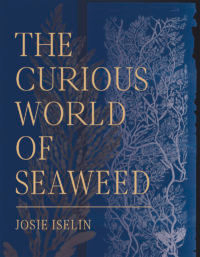
by Josie Iselin
256 pp, Heyday, August 2019
Seaweeds might be various and abstruse, but they are incredibly important: they provide life-giving oxygen, safe habitat, and food for entire ecosystems, and rely on the balance of those ecosystems (especially, in Northern California, the presence of sea otters) to flourish. And Iselin peppers her essays with intriguing snippets of science and history. The three types of seaweed—red, green, and brown—are barely related; the browns are separated from the other two by millions of years of evolution. An Englishwoman named Kathleen Drew-Baker unwittingly and singlehandedly saved the Japanese seaweed industry in 1949 by describing the tiny reproductive stage of nori in Nature—which allowed Japanese scientists to begin farming it. And the preeminent and spirited phycologist Isabella Abbott, the first Hawaiian woman to get a PhD in a science, was the main author of Marine Algae of California, the 1976 bible of Pacific coast seaweeds enthusiasts fondly refer to as Big MAC.
These delightful tidbits notwithstanding, I found myself growing increasingly dissatisfied as I made my way through the book. Profiling each species or genus of seaweed one by one isolated them from each other, and gave me no sense of how they interact with each other (if they do) or how they relate to one another spatially. In the same way, it was difficult to keep track of the various scientists, naturalists, and seaweed enthusiasts temporally and within the greater web of scientific relationships and influence. Each essay discusses a particular seaweed’s range, appearance, color, reproductive habits, biology, and the lives of the scientists involved in finding and studying them. There’s something bracingly comforting about this procession of “unassailable little truths,” to borrow John Steinbeck’s phrasing from The Log from the Sea of Cortez. But the actual experience of reading those facts became overwhelming.
Thankfully, there were gorgeous renderings of seaweed to look at. Iselin’s technique of scanning the algae highlights their alluring textures and glorious hues, and provides a crystal-clear view of their anatomy. One especially arresting image is of Mazzaella splendens or rainbow leaf, which sprawls across the bottom of two pages looking unexpectedly like the Milky Way, with its deep reddish-purple and glowing white perforations. But this celestial visual reference is appropriate—seaweeds are incredibly good at converting light from a star (that is, our sun) into literal, graspable stuff through photosynthesis. “All of these colors are a reminder of seaweed’s essential role as primary producer of our near ocean waters, performing the unique transformation of light energy into organic matter,” Iselin writes on the same pages.
Iselin also has an artist’s precision when it comes to describing the seaweed itself: Agarum or colander kelp is “flamboyant and sculptural”; nori is “distinguished by its three-dimensional flounce and graceful transparency.” Of a particularly majestic lithograph of bull kelp, she writes: “The profusion of blades emanating from the large bladder swaddle the circling stipe, which reduces through fold and squiggle to a diminutive holdfast on a tiny rock. The entire organism creates a regal crown announcing itself as the influential player in the hierarchy of marine organisms.”
Or take this winning description of the subject of the book’s first entry, feather boa kelp:
Whimsical gas-filled bladders punctuate the length of the kelp, like oversized beads. These beads hold the entire snakelike affair aloft towards the ocean surface. In my quest to make a visual record of the seaweeds of the Northern California coast, I found that Egregia is one that must be captured quickly in the studio before it loses its luster and fabulousness. It cannot be dried and pressed. It has to keep a bit of the ocean with it to display its luminous olive hue and unique and astonishing profile. Nothing in the plant kingdom of our terrestrial world, no tree shapes or branching patterns, ready us for Egregia. It is purely a concoction of its ocean environment.
This kind of view—of algae as art object—is fundamental to the way Iselin sees seaweed. More specifically, it’s a view of seaweeds that rejects seeing their value as something commercial, financial or “useful.” Works of art are usually prized for their simple physical existence, not for their usefulness. Iselin wants us to see seaweed that way too, not as something to be deployed to oxygenate oceans or engineer ecosystems, but as something to be respected and empathized with as fellow living beings. “Seaweeds, kelps, and sea grasses, as habitat engineers, are acknowledged as the foundational organisms they are, organisms that we might rely on to climb out of the corrosive environmental situation we humans have created in our oceans,” she writes. “And yet, is that their job? The extraordinariness of marine botanicals, the vast array of red, green, and brown algae as well as the sea grasses, must be recognized, cherished, and revered fundamentally, not as a lifeboat to our solipsistic notion of the planet, but in and of themselves.”
It was only while drafting this review that I began to think I had been reading this book in precisely the wrong way. Which is to say that I read the majority of this book in one marathon sitting, holed up in a trendy hotel in New York on a trip dedicated to finding a place to live in that city on the other side of the country. Much like my apartment hunt, the process of jamming through more than one hundred pages of The Curious World of Seaweed in a day was unglamorous, rushed, and marked by a determination to finish as quickly as possible.
I began to rethink my initial reactions to The Curious World when I reread Iselin’s explanation for the way she structured the book. “These essays, arranged for visual dynamism and roughly by chronological theme, do not create a linear narrative but will build up on each other so that a sensibility about the seaweeds might emerge, much as algal detritus and drift can, given the conspiracy of tide, current, and coastline, accumulate in a particular cove or beach into a remarkable mass of scraps of shape and color,” she writes.
This is a book to be dipped into and wandered around in as images strike your fancy, not read straight through with laser-like focus. Perhaps, I realized, one should not approach this book the way a New Yorker would navigate the city, with utmost speed from point A to point B, but more like a Californian combing a beach, meandering over to promising piles of wrack and looking, really looking, at them according to the dictates of interest and not expedience. Not dutifully or systematically, but with openness, curiosity and delight.
In her introduction to The Curious World of Seaweed, Iselin writes that it’s important “to learn not only about the seaweeds of our region, but also from them—from their resilience and toughness, their resourcefulness and efficiency, their deep and abiding connection to the ocean, their poetry and magic.” I found this sentence pretty but vague when I first read it. Now, as I prepare to leave the state I’ve lived in practically my whole life, I’ll take the lessons of its seaweeds with me.

